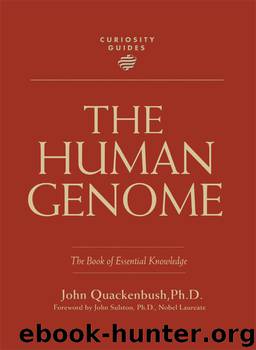Curiosity Guides by John Quackenbush

Author:John Quackenbush [Quackenbush, John]
Language: eng
Format: epub
ISBN: 978-1-60734-515-2
Publisher: Charlesbridge
Published: 2011-03-18T04:00:00+00:00
FIGURE 5: HOW DNA MICROARRAYS WORK
In DNA microarray expression analysis, an RNA “target” sample obtained from a biological sample is labeled with a fluorescent dye for detection, then applied to a DNA microarray gene chip on which DNA probes represent some or all of genes in the genome. The single-stranded RNA hybridizes with its complementary probe on the array to become a double-stranded nucleic acid. The degree of binding is assayed by measuring the fluorescence of each DNA probe to determine the level of expression of the corresponding gene.
One of the first applications of microarray technology was in the study of cancer. Between 1996 and 1998 many microarray studies focused on various aspects of the disease, such as comparing tumor tissue with the surrounding normal tissue to find differences in gene expression, or comparing the clinical stages of cancer to understand which genes distinguished them from one another. These early studies showed cancer to be a very complex disease that often exhibited confusing patterns of gene expression. In 1999, however, two studies, one of leukemia and the other of breast cancer, offered a new perspective on cancer—one based on genomics.
Leukemia is a less complex cancer of the blood-forming tissues typified by the overproduction of white blood cells in bone marrow and by the spread of abnormal cells to other organs. Todd Golub and his colleagues at the Dana-Farber Cancer Institute in Boston, Massachusetts, used DNA microarrays to examine two leukemia subtypes: acute lymphoblastic leukemia (ALL) and acute myeloid leukemia (AML). ALL is most common in children and characterized by an excess number of immature cells known as lymphoblasts, while AML is a cancer of the myeloid line of cells and typically affects adults. (Both lymphoblasts and myeloid cells are types of white blood cells.) Golub and his coworkers showed that genes expressed differently in ALL and AML (turned up in ALL and down in AML, or vice versa) and that their expression patterns could be used as a biomarker to predict whether a patient had ALL or AML (see Figure 6).4
Download
This site does not store any files on its server. We only index and link to content provided by other sites. Please contact the content providers to delete copyright contents if any and email us, we'll remove relevant links or contents immediately.
Sapiens: A Brief History of Humankind by Yuval Noah Harari(14315)
Sapiens by Yuval Noah Harari(5321)
Pale Blue Dot by Carl Sagan(4952)
Homo Deus: A Brief History of Tomorrow by Yuval Noah Harari(4871)
Livewired by David Eagleman(3729)
Origin Story: A Big History of Everything by David Christian(3666)
Brief Answers to the Big Questions by Stephen Hawking(3392)
Inferior by Angela Saini(3293)
Origin Story by David Christian(3170)
Signature in the Cell: DNA and the Evidence for Intelligent Design by Stephen C. Meyer(3098)
The Gene: An Intimate History by Siddhartha Mukherjee(3074)
The Evolution of Beauty by Richard O. Prum(2963)
Aliens by Jim Al-Khalili(2802)
How The Mind Works by Steven Pinker(2775)
A Short History of Nearly Everything by Bryson Bill(2659)
Sex at Dawn: The Prehistoric Origins of Modern Sexuality by Ryan Christopher(2500)
From Bacteria to Bach and Back by Daniel C. Dennett(2462)
Endless Forms Most Beautiful by Sean B. Carroll(2442)
Who We Are and How We Got Here by David Reich(2416)
